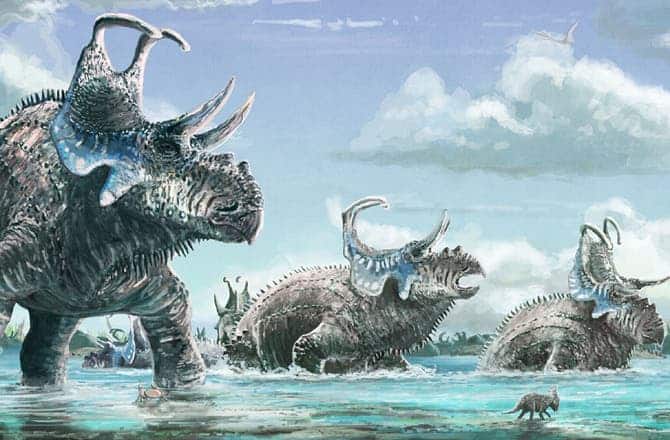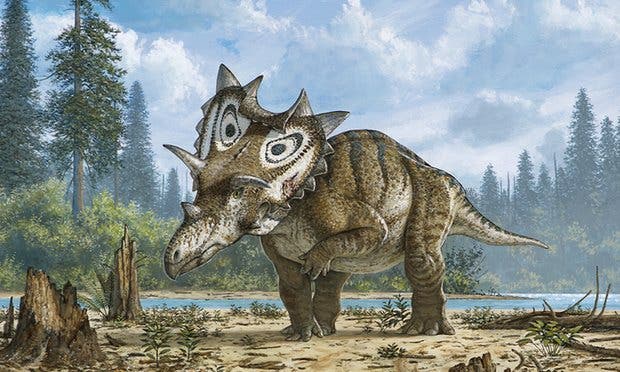Paleontologists have discovered two new triceratops relatives that simply looked amazing. One had two forward-curving spikes running from the back of its shield, in addition to the classic triceratops horns, while the other sported beautiful coloring akin to butterfly camouflage, but also a tragic life story.

Let’s start with Machairoceratops cronusi. It lived some 77 million years ago in the Cretacious period, grew to 26 feet (8 meters) long, and had five horns coming out of its shield, head and parrot-like beak. This very spiky shield, called a “frill”, was likely used for sexual display and mate competition, researchers say. The distinct frill also served to help dinosaurs of the same species recognize one another, the team reports in PLOS ONE.
Like its famous cousin, Machairoceratops c. was a plant eater. The dino was found in Utah’s Grand Staircase-Escalante National Monument by a team led by Ohio University paleontologist Eric Lund.
“An effort like this underscores both the necessity and excitement of basic, exploratory science in order to better understand the history of the world around us,” noted study co-author Patrick O’Connor, who is a professor of anatomical sciences at the Heritage College of Osteopathic Medicine. “Even in a place like western North America, where intense work has been conducted over the past 150 years, we are still finding species new to science,” he added.

The other horned dinosaur was discovered in Montana over a decade ago, but was only recently identified.
When Bill Shipp bought his new ranch over ten years ago, he hired an amateur paleontologist to teach him how to hunt fossils. He actually found one in the Judith River geological formation, another Triceratops relative called Spiclypeus shipporum which lived 76 million years ago.
“People ask me all the time, ‘How did you find it?’ ” Shipp told the Associated Press “And I always say ‘I accidentally found it on purpose.’ I was actually looking for it with no expectations of finding anything. But there it was.”
Spiclypeus, the genus’ name, means “spiked shield”, while shipporum honors the Montana rancher who made the discovery.
It was only recently that a team of researchers from the Canadian Museum of Nature, led by paleontologist Jordan Mallon, actually identified the dinosaur as a new species to science. When it was alive, Judith — as the researchers christened this particular specimen — shared the conifers and fern prairies with only a couple other horned dinosaur species. Even so, its distinct orientation of horns and spikes on its massive frills made it stand like one in a million.
This particular specimen, named Judith, didn’t have an easy life. The upper bone in the front left leg bore clear signs of disease, likely arthritis, doubled by a bone infection.
“It’s an exciting story, because it’s a new species, and yet we have this sort of pathetic individual that suffered throughout its lifetime,” Mallon said. “If you’re hobbling along on three limbs, you’re probably not going to be able to keep up with the herd.”
Shipp found the dinosaur in an afternoon barely breaking a sweat, but only a couple of dinosaurs have been discovered in the Judith formation and not out of lack of trying. In the past century, many expeditions have been made in the area with little to show. As such, Spiclypeus shipporum is truly remarkable filling the missing puzzles that tell the story of how Cretaceous life was like in Montana.





